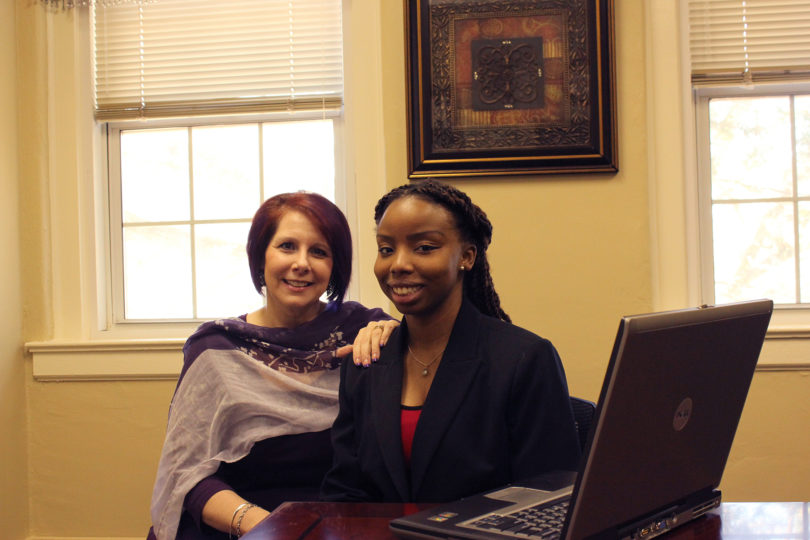For some, an island is a place of retreat or isolation. A place to be alone with your thoughts.
But the virtual island created in BreakThru, a project combining the talents of researchers from UGA and the Georgia Institute of Technology, is a place for students with disabilities who want to work in a science, technology, engineering or mathematics-related field. Here, students find small mentoring nooks, large classrooms, an amphitheater, floating cafes, lounges and green space-all computer generated based on the online virtual world Second Life.
Using avatars, this is also a place for students to meet with their mentors, take part in STEM-related experiences, such as scavenger hunts, and access more resources through the Internet. BreakThru’s avenues of communication create a relationship called e-mentoring, and it’s breaking new ground in the ways students engage with their mentors.
The e-mentoring island is only one type of social networking tool used by BreakThru, which began five years ago with a grant from the National Science Foundation. The project pairs students who have disabilities with a mentor who has expertise in a STEM field to help foster the students’ pursuit of a STEM degree. The e-mentoring experiences help hone students’ interest in a career or simply expand their knowledge of a STEM-related subject.
Now in its final year, the team is adapting other tools, such as smartphone texting and Google Chat, to keep the project on the cutting edge.
“We’re always looking at access and how these students can have access to STEM through social media,” said Noel Gregg, a professor in UGA’s College of Education and one of two principal investigators on the project.
A new world
People with disabilities represent a minuscule percentage of the population working in a STEM career, Gregg said. The goal of BreakThru was to recruit high school and college students who had an interest in a STEM-related career path, but might not follow through with the decision because of their disability.
Students and mentors are matched up using several factors, including the student’s disability, background and interest or education. When paired with a mentor, the students access the knowledge and support of a STEM expert. BreakThru provides training for the mentor, a small stipend and the framework for the student and mentor to communicate.
Originally, the e-mentoring island was the focus of the program. Georgia Tech’s programmers, led by co-principal investigator Robert L. Todd, created a world where students could create an avatar and listen in on guest speakers, find study rooms or conduct experiments. But as smartphones became more ubiquitous, the ways to connect with fellow students and mentors evolved.
Now, with even more ways to interact, it’s more about finding the right tool for the student and mentor. The BreakThru researchers also realized they can apply what they’ve learned to other modes of learning, such as online classes.
A model citizen
In BreakThru, mentors are there to help the students navigate bureaucracy, keep them on track in their life and show them opportunities for learning, research and career turning points.
This relationship is also how the program gets its name. Through social media and virtual environments, students and their mentors “break through” the traditional form of top-down mentoring. Smartphone text messages or virtual worlds make it possible to connect over long distances, and the one-on-one connections help eliminate barriers that once would have discouraged students from pursuing a STEM class or career.
“Mentors link students to resources that support learning, including other BreakThru mentors,” said Gerri Wolfe, program coordinator for BreakThru and liaison for the Regents’ Center for Learning Disorders, which is housed in the Franklin College of Arts and Sciences. “They help build a community of support for students and create a dynamic group mentoring experience.”
And because an overwhelming number of mentors stay in the program year after year, their participation shows the experience is positive for both themselves and the students.
A lasting benefit
The success of BreakThru is measured differently depending on the student, Wolfe said.
For high school students, success is a nurtured interest in the field. College students benefit from the life skills that mentors model for them.
“One of the things mentors stress is the ability to understand your unique educational needs and communicate those needs,” Wolfe said.
Often, students feel they’ve been labeled early on with a disability and are reluctant to communicate if they have a specific need.
“You have to ask for everything in college, to be a self-advocate,” Wolfe said. “And that’s a big change for many students transitioning from high school.”
As the grant period comes to a close, the future of BreakThru remains uncertain. Gregg said the overall goal was to create a program that could be scalable, depending on the size of the community or institution that wants to implement the program.
The next year, she and her team will look more closely at other applications for mentor programs, other ways to virtually connect with a mentor and ways the BreakThru model can apply to more traditional online learning.
But in its current form, BreakThru can be adapted by other institutions interested in guiding a more diverse student population to STEM fields. The mentoring model also can be adapted to other academic situations, according to Wolfe.
“E-mentoring does seem to make a difference, and we have some great success stories where students left high school and went to college and are now working in a STEM field,” she said.





